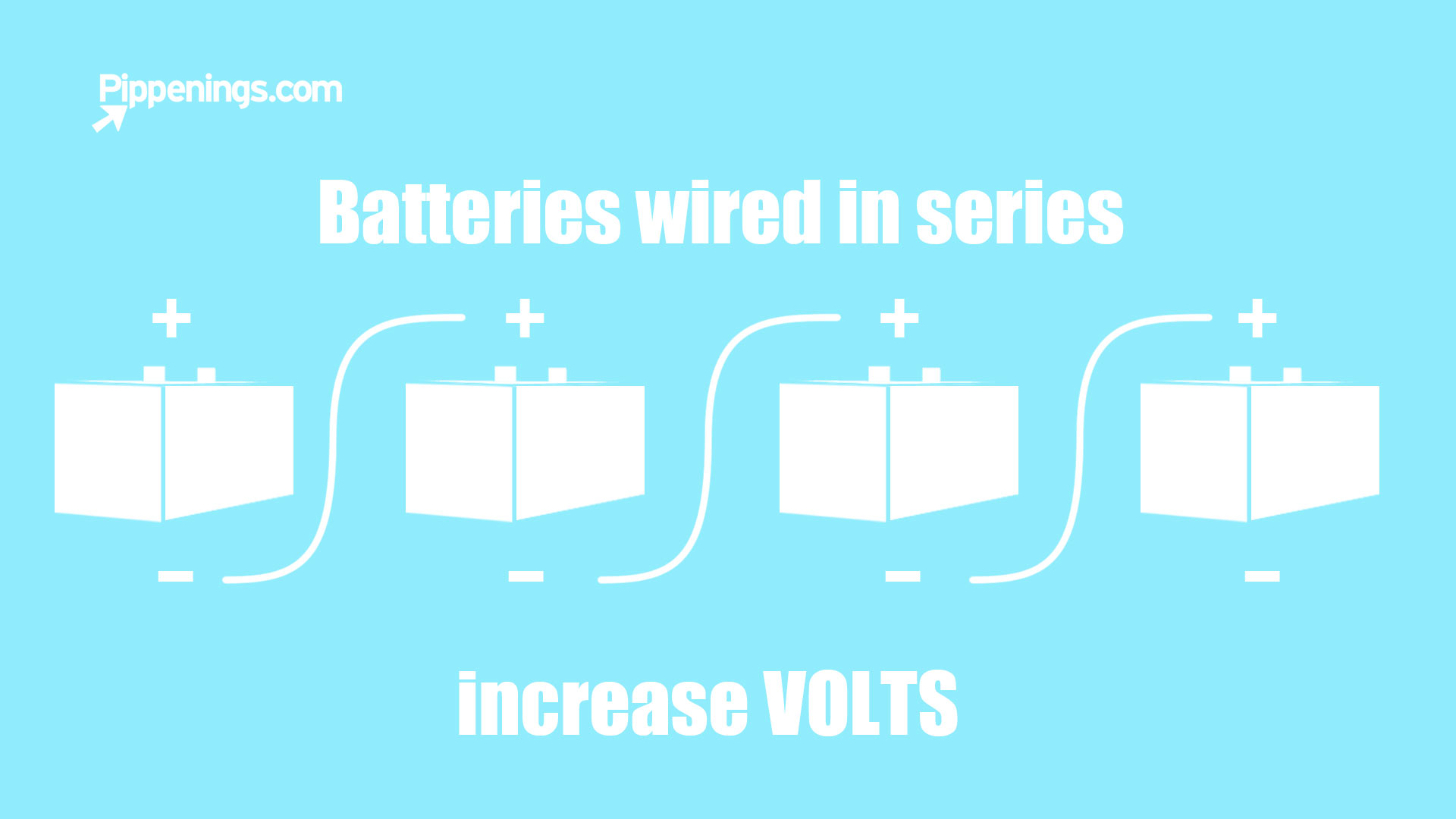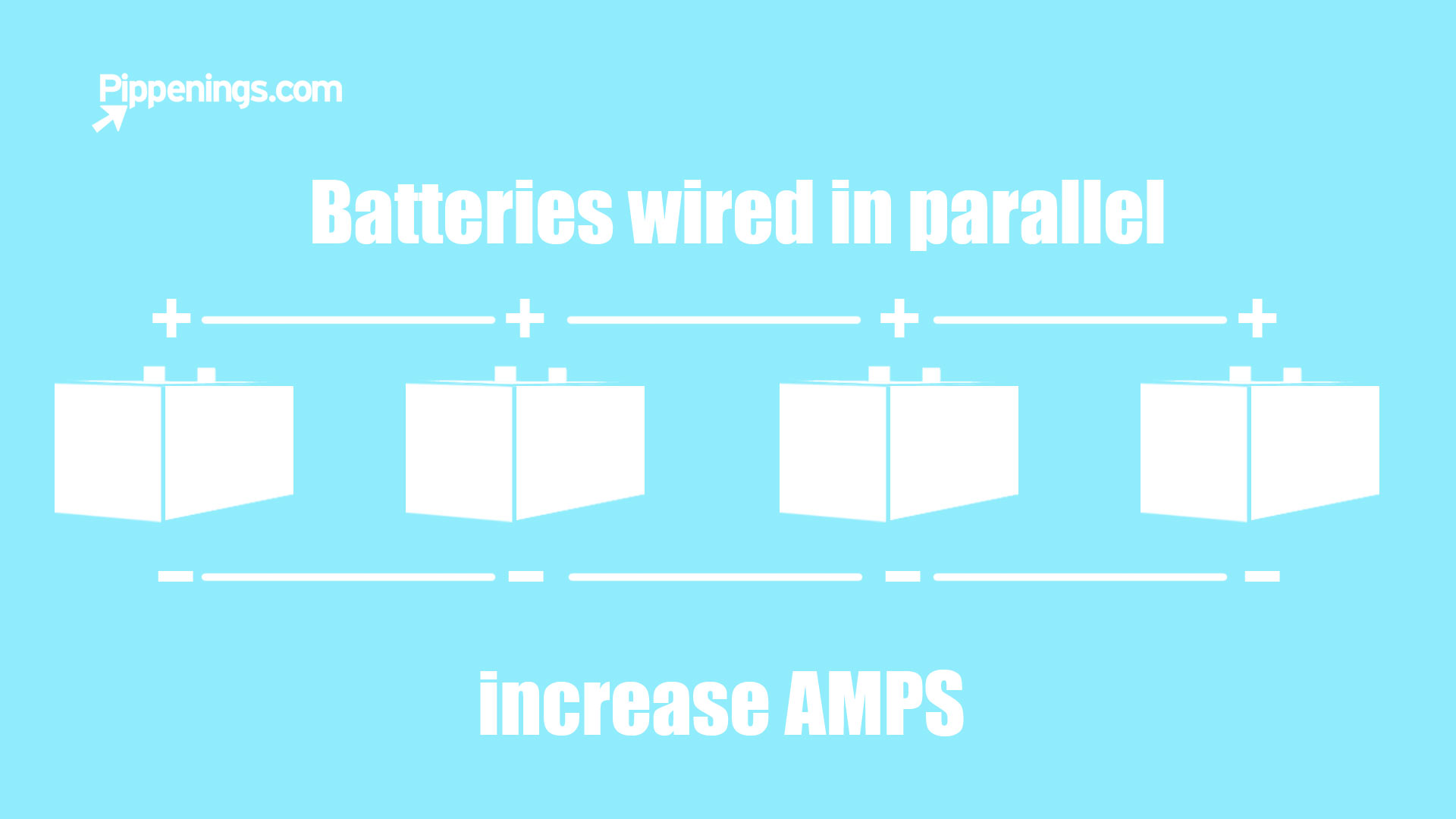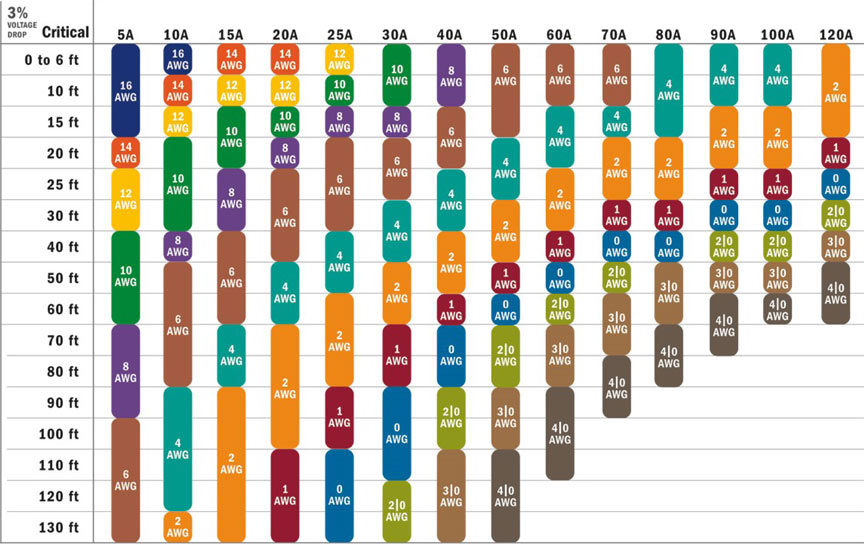RV Solar Batteries:
Batteries are kind of like the heart and soul of your solar or renewable energy set up. If you’ve got solar panels, you’re not running off solar power, you’re running off the energy stored in your batteries and your panels just recharge those batteries.

Batteries store energy in amp hours. Let’s say your battery has 100 amp-hours. That means you can run a one amp appliance for 100 hours or a two amp appliance for 50 hours…etc.

Batteries are rated in cycle life and use either a deep-cycle application or a shallow cycle application. One cycle of a deep-cycle battery is from fully charged to fully discharged. They’re made to be used to almost a full discharge and to be used heavily for long periods of time.
Shallow cycle batteries are used to crank amps for just a short period of time, like car batteries.
For all your renewable energy storage and off-grid needs you’ll only want deep-cycle batteries. If you can only use the top 20% of the deep-cycle batteries, they’ll last a lot longer, like 10-20 years. So the more batteries you have, the less deeply you’ll use them and the longer they’ll last.
RENEWABLE ENERGY STORAGE BATTERY TYPES:
The two most common types of batteries used in renewable energy storage are lithium-ion and lead acid.
Lead Acid
There are two distinct categories of lead acid batteries. You have flooded or wet and sealed or valve regulated.
Flooded batteries are the ones that you can remove the top caps to expose holes into the batteries that you have to fill with distilled water occasionally. These are the cheapest because they require that little bit of maintenance. This category of lead acid batteries also require a constant upright position, ventilation and maintenance of making sure the water level is higher than the lead plates inside the battery.

The other category of lead acid batteries are those that are sealed or also called valve regulated. This category of lead acid battery can be found in deep-cycle or shallow-cycles applications. Sealed batteries don’t need regular maintenance and can be mounted sideways but not upside down.
The two types of sealed lead acid batteries are AGM and gel. AGM is beginning to phase out gel batteries. AGM batteries work with most charge controllers. AGM batteries also charge and discharge faster and if a gel battery is charged on an incorrect cycle or too quickly it can cause boiling in the gel leaving gas bubbles inside.
These are all lead acid but they have different chemistries. They all hold or contain their electrolytes in a little bit different way.
Lithium-Ion
You’ll find Lithium-Ion batteries in your cell phones, cameras, laptops and power tools where they began. They’re still new on the renewable energy storage scene but growing in popularity and development quickly.
Lithium batteries that are made for renewable energy storage are almost always deep-cycle and just like lead acid, if you can only deplete them to 80%, they last much longer.
The lithium-ion batteries don’t have as many differing chemistries, categories or types so let’s now compare the main differences between lead acid batteries and lithium-ion batters.

Lead Acid vs Lithium-Ion:
LIFE SPAN
Lithium-ion batteries have a cycle span of 5000 cycles compared to lead acid batteries ranging 400-800. That’s six to ten times a longer lifetime with the lithium-ion batteries.
SIZE and WEIGHT
Lithium-ion batteries are 1/3 the weight of lead acid batteries and smaller too!. That’s great for RVing! That also means lower shipping costs when ordering them.
PERFORMANCE
Lithium-Ion batteries have a low self-discharge which means they don’t lose energy overtime by just sitting there. The energy you put in, is the amount of energy you can get out of it. The higher loss in lead acid batteries might explain the less cycles available over its life.
And, even on a low charge, lithium-Ion batteries will output same voltage but a lot of lead acids will output a lower and lower voltage reducing power efficiency greatly. So the power output remains constant versus a slow die off.
If going to be using a lot of power in an 8 hour period (like at night) when your batteries aren’t charging or won’t charge soon after, (or rather, you’re using a lot at once) lithium is much MUCH MUCH more efficient and well suited.
THERMAL TOLERANCE
Both batteries age slower over time in cooler temps but the lithium-ion can last longer in high temps up to consistent temps of 120 than the lead acid battery can. If you’re living or staying in hot climates, it behooves you greatly to go with lithium-ion. Lithium-ion batteries are not only better for hot climates especially but the lithium-ion batteries are also much more efficient in extreme cool temps down to -20. Both lead acid and lithium-ion batteries lose capacity in the cold but lithium-ion does so to much lesser extent.
MAINTENANCE
Lithium-ion is a low maintenance battery, an advantage that some lead acid chemistries cannot claim.
DEVELOPMENT
Lead acid batteries or over 100 years old. Their manufacturing and chemistries are well developed, trusted and reliable. Lithium batteries were first conceived in the 1970’s and became more popular in the 1990’s.
ENVIRONMENTAL
Manufacturing lead acid batteries has a worse environmental impact and has worse processing side effects. To make them, more materials are mined. However, recycle rate is high and very beneficial. Lithium-ion battery manufacturing is safer for the environment but has its drawbacks. However, the recycling process isn’t as developed yet but is expected to grow to rival that of the lead acid batteries.
PRICE
Lithium-ion batteries a more expensive initially coming around twice the cost of sealed lead acid batteries. But in a full life time, they’ll last longer than lead acid batteries which you’d have to continue buying more often, so it can work out cheaper.
Basically, lithium-ion batteries kick some serious heinie when it comes to comparing the basics with lead acid batteries and will serve you better and longer if you can spare the higher upfront costs.
HOOKING UP BATTERIES
Series vs Parallel
Most RVs come with an electrical system of 30A or 50A of current at 12V. A lot of motorhome coach batteries are configured for a 12V system wiring either 12V batteries together in parallel or pairs of 6V batteries together in series to output 12V.
Remember that, just like in wiring your PV panels together, either parallel or series can increase or maintain power, the same holds true for battery connections.
Batteries wired together in parallel will maintain the voltage and increase amperage and batteries wired together in series will maintain amperage and increase voltage.


It’s important to have same age on your batteries. If batteries are hooked up in parallel and one is weaker, the other batteries will send support to that battery to try to equalize, meaning you lose that power that their sending to the other battery. When hooked up in series, they’ll charge evenly.
If you’re connecting a battery bank for a 12V system, you can use all 6V batteries. In this case, you would use parallel connection of pairs in series. So you’re using series connection AND parallel connections. You would have a little cluster of two 6V batteries connected in series, then you’d have another cluster of two 6V batteries (and maybe more) in series and these two clusters of pairs would connect together in parallel.
24V system vs 12V system:
So it’s most common to see RVs with 12V systems but it’s an option and possibility to have a 24V system in your RV. In general, converting your RV to a 24V system is beneficial if you have anything more than 150A of current. So that’s a lot more than the standard 30 or 50A system. If you had a 24V system, your batteries would need to be wired together to output 24V or you could just use 24V batteries versus the more common 12V batteries used in RVs.
Lithium batteries tend to most often be 24V batteries whereas lead acid batteries can come in a variety of voltages most common being 6V or 12V.
If you use 24V batteries to power a 12V system in your RV, your inverter and charge controller must be able to accommodate those higher voltages from the lithium-ion batteries to ensure compatibility. Many inverters and charge controllers do have the capability to adjust between the option of a 12V and 24V system and they must be set accordingly. Swapping out to a 24V system might also mean updating certain breakers and cable sizes.
Battery cables:
When hooking batteries up, the cables should be as equal as can be to the other batteries. The shorter the cable length the better. Try to keep cables from batteries to the inverter as short as possible to reduce power loss as well as keep cables from the charge controller to the batteries.
How big should the cables be? You can use an ampacity chart like the one below to figure wire sizing. You just match up the amps you’ve got running with the length that your cable needs to be and find the intersect point on to see which size gauge of wire to get.

Check out other videos of this series of four to learn more about panels, charge controllers, inverter/converters and AC/DC power and how to determine how much energy you use.

Very helpful series of information…..thanks!
Thank you so much. Glad to hear that!
Thank you for sharing your knowledge.
I am new to Full time RV ing.
I have started looking into more research and continual updates on how to live simply.
Off the grid, energy wise and self sustaining kind of life.
Thank you for sharing and I will continue to check on this new page I found that is useful and very helpful.
My contact information for more Info or questions help and answers.
Jacek Szczygiel
Polski.Jacek.a2z@gmail.com
(928)485-1973
Thank you so much Jacek. I’m happy to hear you’re getting a lot out of my RV living videos 😀
Did you look at Lifepo4 cells?.. I only know them from RC hobby , but I have a feeling they should actually be good for solar…
I didn’t, I just looked for the cheapest on eBay. I’m sure there are any suppliers out there though that would work great. 🙂
Thanks for the great videos, Pippi. Clarifying question about having the “same age” of batteries in a bank: is this also the case for lithium ion? I want to go lithium ion but in a year or three add on to the battery bank when I can — I know that is not idea with lead acid. Does lithium ion perform differently in this regard?
Thanks kindly!
I’m honestly not sure but I would tend to think so especially if they are connected in parallel.
I recently watched your video on building your battery box, and where you put wire to hold the battery’s in place, which was a idea, but could I suggest if you have any extra of the flat steel that you run it over the top with some rubber between the steel and the battery’s and the bar secured to your frame with threaded rod which you could be bent and put in the holes to replace the wire and the through the plate . this would keep the batteries from bouncing around . I have enjoyed watching your video’s it’s great to see females with such self confidence in themselves doing diy keep up the great work Bill Fitch
Thanks Bill
Hi Pippi,
Great job on your videos and website!!
I am brand new to the RV world. I just bought a new Toy Hauler and am looking to learn all I can. I watched one of your videos where you got new Crown batteries, Flooded Lead Acid and were kind of down on Lithium but this article sounds like you are more in favour of them now. Are you having second thoughts about the FLA or why the change of opinion?
The theory of Lithium is better than FLA. But in practice with some of the most knowledgeable people on the internet with solar and especially RV solar, FLA is the way to go. FLA is also the “green” choice for batteries. Check out Handy Bob for more info.
Thanks for the reply Pippi, I took a glance at Handy Bob and will go back for a full read. Really enjoy your videos, you are doing a great job of educating us newbies. Thanks. Any idea where you will be for the eclipse? I should be on my way back from Utah around North Platte NE when it goes dark.
I assume it is pronounced Pippi as in Longstockings.
So far I have watched your first video on building a solar panel. I was most impressed with the soldering; tedious work requiring a steady hand. I know almost nothing about this subject matter, but I am generally well educated both in academics and the trades. My interest is Africa. Like all stories mine is a long one, but what you are doing is what they need. Impressed.